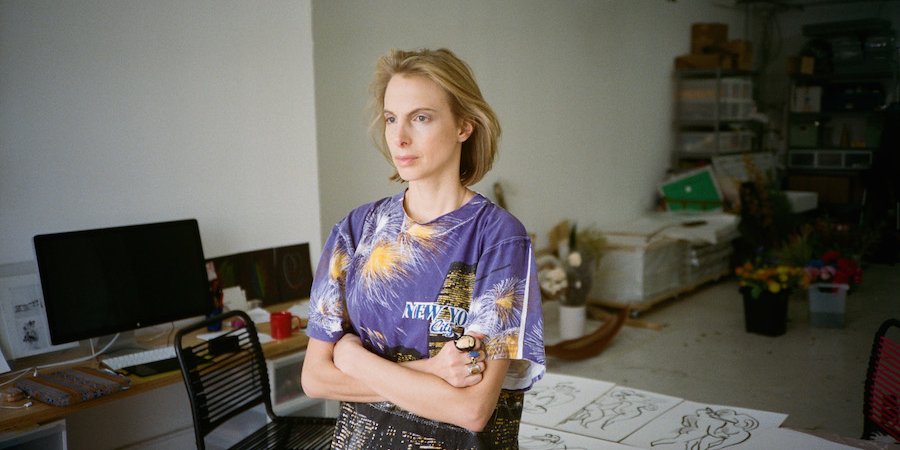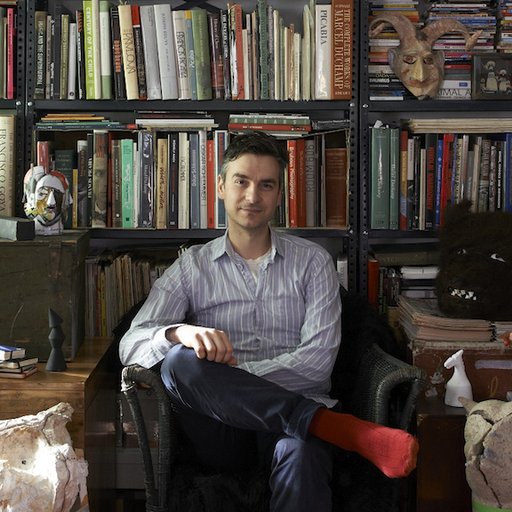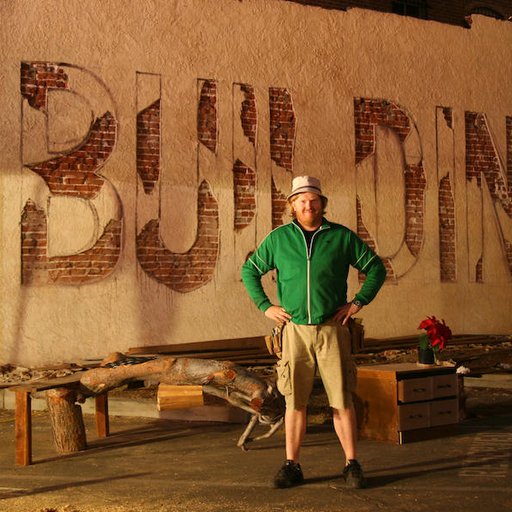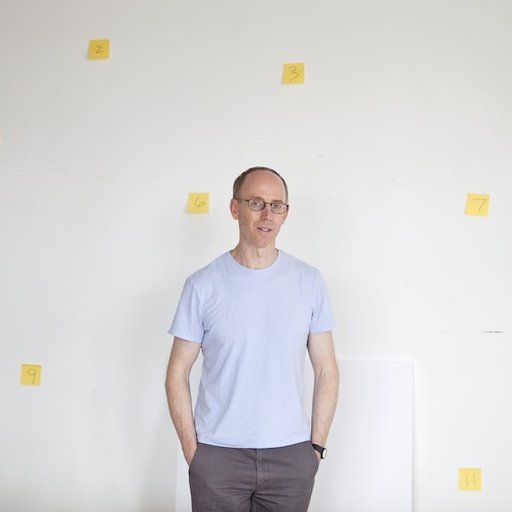These days it seems the art world cannot heap enough accolades on Camille Henrot. The winner of the last Venice Biennale’s Silver Lion for best young artist—for her mesmeric video Grosse Fatigue, a rhythmically driven fugue of creation myths, anthropological artifacts, and spoken-word poetry—she recently won the first Nam June Paik award, and she’s currently up for the Guggenheim's Hugo Boss Prize as well. Wonderfully, her work supports the praise.
Shot through with an electrifying sense of perceptive intelligence about the dawn of the digital era, Henrot’s videos, sculptures, paintings, installations, drawings, and ikebana arrangements are convincing arguments for the how art can get at the knotted issues of one’s time, like a clarifying dream. Now, on the heels of her recent New Museum survey, the artist is venturing into fresh terrain as a curator, co-organizing the inaugural show at SculptureCenter’s expanded space with Ruba Katrib. Titled “Puddle, Pothole, Portal,” it’s a survey of voguish tendency of artworks now that approximate the qualities of a meme, yoking together aesthetics with humor, pop-culture references, and other kinds of elements that succeed online.
To learn more about the thinking behind the show and Henrot’s approach to art more generally, Artspace editor-in-chief Andrew M. Goldstein spoke to the artist about her venture into curating, why she found Gross Fatigue (which she made while doing a residency at the Smithsonian) painful to watch, and why she’s so envious of painters.
How did you come to do your SculptureCenter show?
I met Ruba around 2011 in Paris when she was researching “A Disagreeable Object,” her first exhibition at SculptureCenter as curator, and she invited me to be in the show. I was very proud, because it was my first exhibition in New York, and I felt the project was also a very interesting approach to Surrealism.
A particularly anxious form of humor is at the heart of this show, based on the blurring of humans and machines, animate and inanimate, and other divides. Why is this queasy form of humor relevant or interesting now?
I think that humor is always a reaction to a feeling of impotence or despair, and for me the moment we are living in right now is very dark, with conflicts dividing people in a violent way and having an impact on culture and trade. It’s not like we’re living in a very light and unworried moment. And I think that our new access to information is just bringing on more and more worries, because the more you know the more of a chance you have to worry about everything, from googling symptoms for diseases on the Internet to looking at pictures of dead Palestinian children. It’s a very unprotected way of experiencing the violent era we are living in, and humor is the only reaction, because it’s the only way that you can express a disagreement and raise your voice in a way that doesn’t make you feel too ridiculous.
Because I think that after the great moment of political activism in the generation of my parents, for example, there was a wave of of disillusionment, and it’s very clear now that the only way to create change is to act individually, and then an agglomeration of individual actions can cause a major change. But the overall feeling of yourself being small as an individual—a single drop in the sea—is increased by our awareness of how large the world is that’s brought on by the digital era we are living in. So, in a way, humor and playfulness comes from despair.
Humor is also very interesting when it comes to online and social media, because it’s a tremendously effective way of getting a meme to go viral and enter the public consciousness—just think of the ice-bucket challenge. At the same time, because there are so many memes flying around that they come to seem kind of flimsy and disposable. Do you feel this in any way devalues our capacity for engagement?
I have no idea, and to be honest I don’t think it’s a big difference from the past—in a way we are experiencing a return to an earlier moment. Because in the 16th century the way that political opinions were expressed were through caricatures and pamphlets and funny songs that were mocking the people who were in charge. French culture is full of that. So I think humor is the tool that is left to the people who are not in charge. One thing about the exhibition that I'm interested in is that the work is in a child’s frame of mind, because as humans we are all still children in the new world of the digital era.
You know, with me, I’m still not sure how to change the password for my email so that it works on my phone, and I can talk about Instagram but I’ve still never been on Facebook. I feel like I’m an unfinished digital child. [Laughs] I still am uncomfortable with a lot of things that are on the Internet, and I think we all are in a way, because it’s still in the beginning and we don’t know how to do everything yet, or if it’s positive or negative. The exhibition is about that, this erratic moment where we are in between spaces, like in the tunnel in Alice in Wonderland.
The artists are an interesting mix, ranging from young artists addressing the ramifications of new digital technologies to older artists like Teresa Burga, Joachim Bandau, and Keiichi Tanaami whose careers are not well known in the United States. How did you and Ruba choose them?
The two of us decided to not be afraid to have a very broad and non-exclusive approach in the beginning, we just wanted to begin with the concept and find the images that sprang to mind and matched that concept. So I made a folder of images that I grabbed on the Internet or found in books at home, and that was a starting point for thinking about what shapes, what forms, what kinds of cultural references could be connected to the concept. And then we both made lists of artists who we liked and considered relevant, and then we exchanged these lists.
Sometimes both of us agreed on the names, and sometimes we would fight for hours over them. [Laughs] It’s funny, because both Ruba and I are very stubborn, so it was great, because at the same time that there was a feeling of great complicity we are also very different in our approach to things, and Ruba has the experience of doing an exhibition as a curator, and I don’t. I wanted to also keep the freshness and naiveté of what I could bring as an artist, but we also had to match the realities of an exhibition, with a budget, and shipping, and following the artists’ desires.
Is this the first show that you’ve curated?
Not exactly—I actually curated a show in my studio in Paris two years ago for the Berlin Biennale, and it was titled “Le Fond de l’Air Est Frais" after a famous joke by Jacques Lacan that is completely untranslatable but that in French could either mean “the weather is becoming colder” or “the air is becoming scary.” It was mostly American artists who I had met when I first came to New York.
Curating seems like a natural outgrowth or adjunct to your own art, which you build out of copious research and the bringing together of disparate artifacts—an approach that is clearly visible in your captivating visual essay that you wrote for the show’s catalogue, which clearly arose from your research. Do you see them as being related?
Yes and no, because in a way I am a very accumulative person and I can gather together interesting materials, but because I am a very unselective person as well, then when it comes to making things real it’s a little more difficult, because I don’t like to exclude things. In my own work, I like to create objects and films in which everything is included, in a way—having the global, le tout, contained in a single object is something I have been working on for a while. And when it comes to an exhibition with different artists you rediscover that every artist is like musical note—it’s not like the show is a collection of my favorite artists ever, but the artists are all resonating well with one another.
So when we started working on the exhibition, I found that it was really interesting to see how this artist could be resonating with another, but for me a big discovery was the generosity of the curator, who has to trust the artist to make a new work that will resonate the same way with what you planned it to resonate with. I was thinking, “I really want this work, I don’t want a new work,” and Ruba was more open to listening to the artist and doing what they wanted to do. This is not what I expected from my experience as an artist of working with curators, because I always saw them as a controlling authority, but now I realize one actually needs to give up a lot of control and have patience to be a good curator. I’m a lot more sympathetic to curators now.
Transitioning to your own work, archives are central to what you do, and one of the most refreshing aspects of what you do is that you seem to put historical, scientific archives—like those at the Smithsonian Institution, where you had a residency—on a level playing field with the infinitude of information available on the Internet. But there’s obviously a tension there, since so much of the information available online is dubious, or flimsy, lacking the rigor of science. Can you talk about the way you approach these two kinds of resources?
Scientists process information in a way that comes from a more scientific origin but also they come from a position of authority, because science has become a kind of religion in our part of the world. I don’t know if that’s completely true for the U.S. [laughs], but for much of the rest of the world, especially in France, for example, you find the domination of rationality and the scientific method over pretty much everything, in a way that can be experienced as almost a form of brutality sometimes.
It’s important to question the faith you have in anything, and the scientific approach is even based on that principle of doubting everything. The best scientists are always full of questions and doubt. Like, with the ones I met at the Smithsonian’s National Air and Space Museum, there was no question that could be stupid—we could talk about cosmology as a scientific discipline or how the probability of the existence of god has been calculated to a mathematical number, and what it means to do that. These are matters of interrogation that may sound apart from science, but they were taken very seriously by the people I was talking to.
Then, when it comes to the Internet, almost everything is on the Internet, so you can have no generalization.
Can you talk a little bit about your research process? It seems like you must spend hours and hours on derive-like wanderings of the Internet to find such wildly disparate forms of visual information.
Well, I’m not on Facebook or any other social media, except for Instagram, and you can’t find any information there. I actually don’t research that much on the Internet. Yes I do, but I usually read books and then go online to look up the information I find in the books. But it’s very intuitive, and it also comes from conversations I have with friends. I’m lucky enough to have very interesting friends, who point a finger at interesting things.
But of course when I was doing the research for Grosse Fatigue I spent a lot of time online, because the entire database of the Smithsonian Institution is online, but also because all of my books and objects and everything I had was locked in customs for more than six months while I was moving my home from France to the U.S. So basically the computer was my home for this period.
Gross Fatigue was an immediate success when it was shown in the Venice Biennale, going viral with the speed of a new hit song. A hypnotic combination of spoken-word poetry, driving beats, creation myths, and staggering visuals of anthropological artifacts pulled from the Smithsonian’s collection, it somehow managed to wear its blazing intelligence lightly and come across as fun. Why do you think it was such a success?
I don’t know, I think it had something to do with the expansiveness of the encyclopedia and how it was related to the computer, of course, but probably also because it was not detached from a preoccupation with ecology and the effect of Google Image’s flattening of the world on nature and certainly the music. I’m very selective in using music, because it’s very powerful—it’s like the Pied Piper of Hamelin. Music is enchantment, it’s magic, it can capture the attention of everyone and can bring about a very particular state of mind. It’s a manipulative tool, and that’s why it needs to be used with a lot of care, so I don’t systematically use it in my work. But when I was doing it I didn’t expect such a success—I was very anxious, because I thought it was almost painful to look at, with too many cuts and too much information. From my perspective the film was painful, really a “disagreeable object” [laughs], and I gave it the titled “Gross Fatigue” because that really reflected my state of mind while working on the project. So I was surprised when people found watching it an enjoyable experience.
So, now you’ve said that you’re interested in moving into painting?
Yes, and it’s because I envy the lifestyle of the painter very much. I would like to be the kind of painter who can always stay in the studio and doesn’t have to go meet different fabricators and ask for permission to do things, like I usually do for my work. I envy the loneliness and the capacity to focus and also the freedom you can have as a painter making an exhibition in a gallery—you don’t have to worry about the weight on the floor or what truck to use or any of the questions that are right now slowly preying on my brain.
What are you working on now? Now that you are represented by Metro Pictures, do you have any shows upcoming there?
Yes, we have a show planned next fall, but what it will be I have no idea yet.























